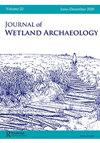萨福克郡Waveney山谷的史前晚期木材排列:Barsham沼泽的挖掘
Q1 Arts and Humanities
引用次数: 1
摘要
摘要本文介绍了英国萨福克郡Barsham沼泽的发掘结果和相关的古环境分析。场地由三根橡木桩组成,建在Waveney河的古河道边缘。这条路线已被追踪了30多米,但遗址的终点都没有被挖掘出来。根据树木年代学测定,这些木材的采伐日期介于公元前8年至公元8年之间,表明该结构的铁器时代晚期。没有发现其他文化材料。对相关沉积物的古环境分析表明,该遗址位于韦夫尼河(River Waveney)的一条浅河道边缘,当地有水生植物和桤木植被,并有证据表明,在更广阔的景观中,有更开阔的灌木丛和牧区环境。这条通道似乎是在公元11世纪填满的,上面覆盖着一层薄薄的腐殖泥炭,与木桩的最高保存水平相对应。很可能任何最初由木桩支撑的上层建筑在这个时候最终已经分解或拆除了。该遗址与河下游约3公里处的贝克尔斯遗址进行了比较,贝克尔斯遗址的挖掘发现了一个三柱排列,也可以追溯到铁器时代晚期,但有证据表明罗马-英国时期的活动。讨论了这些站点可能的形式和功能。本文章由计算机程序翻译,如有差异,请以英文原文为准。
A Late Prehistoric Timber Alignment in the Waveney Valley, Suffolk: Excavations at Barsham Marshes
Abstract This paper describes the results of excavations and associated palaeoenvironmental analyses at Barsham Marshes, Suffolk, England. The site is a triple post alignment of oak stakes built at the edge of a palaeochannel of the River Waveney. The alignment has been traced for over 30 m but neither terminus of the site has been excavated. Dendrochronological dating of the timbers has produced a range of felling dates between 8 BC and AD 8 indicating a late Iron Age date for the structure. No other cultural material was recovered. Palaeoenvironmental analyses of the associated deposits indicate that the site was located at the edge of a shallow channel of the River Waveney with local aquatic and alder carr vegetation and evidence for more open scrub and pastoral environments in the wider landscape. This channel appears to have infilled by the 11th century AD and is overlain by a thin layer of humified peat, corresponding to the uppermost level of preservation of the stakes. It is likely that any superstructure originally supported by the stakes had finally decomposed or been dismantled by this time. The site is compared to that of Beccles some 3 km down river where excavations have revealed a triple post alignment also dating to the late Iron Age but with evidence for activity during the Romano-British period. The possible form and function(s) of the sites are discussed.
求助全文
通过发布文献求助,成功后即可免费获取论文全文。
去求助
来源期刊

Journal of Wetland Archaeology
Arts and Humanities-Archeology (arts and humanities)
CiteScore
1.40
自引率
0.00%
发文量
6
期刊介绍:
The Journal of Wetland Archaeology publishes a wide range of contributions in all fields of wetland archaeology. It includes scientific and methodological features, geoprospection, environmental reconstruction, wetland hydrology, cultural aspects of wetland archaeology, as well as conservation, site management, legislation, and site protection. All periods and all geographic regions are covered.
 求助内容:
求助内容: 应助结果提醒方式:
应助结果提醒方式:


